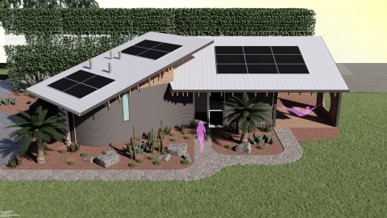
Woodbury University
Team Name: SolarFutures
Build Location: Burbank, California
This 477 ft2 home will help provide relief for the housing insecure, and features first-of-its-kind construction technologies, such as 3D concrete elements.
Project Summary
We have designed a 477 sq ft home that falls under the broader definition of a micro-unit using emerging technology—3D printing—to construct the first such single family residence in Los Angeles. The unit will have the option to self-sustain for water, power, and connectivity, leveraging all aspects of solar energy. The unit is designed to configure quickly for a range of use cases: young and emerging professionals keen on micro footprints as well as housing for seniors who might be down-sizing; low-income populations, homeless persons, and individuals who are housing insecure in need of abode.
The intent is that our micro-unit will house a student who is housing insecure in its first phase of use. We anticipate that local government, which has supported our project, will use it as a template for constructing faster and smarter housing using 3D printing technology to address our housing challenges. In addition, it is an example of how to build high performing and more sustainably designed housing to address climate change.
Design Philosophy
The philosophy that underpins the project revolves around using emerging technology to create smart buildings that solve the complex problems we, as a society, are experiencing today: a changing climate, housing affordability, and a rising homeless population.
Our goal is to create a technologically innovative, sustainable, affordable, and healthy home with a positive impact on its natural and human ecosystem. The project pursues three primary strategies: 1) experiment with emerging technologies in construction, 2) engage regenerative practices that improve the ecosystem in which we work, 3) build faster, smarter, and more affordably to ameliorate the housing and affordability crisis.
The home was envisioned as a contemporary housing model with the use of concrete as the primary building material. Concrete is ubiquitous and is used the world over. It is recyclable as well. We aimed at making the concrete more sustainable by introducing fly ash and carbon sequestration in the mix design. Wood elements provide a warming aesthetic that offsets the concrete. We used a metal roof as a line of defense against wildfires that are common in California. The concrete wall assembly adds to the resiliency strategy of the unit.
The unit presents capability to self-sustain for water and power in an emergency as an off-grid-ready unit. Harvested solar powers the unit and energy is stored in a battery. Rainwater is harvested and re-circulated for irrigation. Graywater from the shower is captured, treated, and circulated for toilet flushing. An air-to-water system or Direct Air Capture (DAC) will be installed in the future as part of the overall system design for resiliency and drinking water.
Photos
Market Analysis
The project investigates three key challenges:
Challenge 1 – A Changing Climate: Using renewable energy and emerging technologies to build sustainably is imperative in a 21st century context. Self-sustaining structures, decentralized utilities, distributed technologies, and smart building typologies help mitigate climate change. Furthermore, building sustainably helps manage the risks posed by a changing climate while ensuring stewardship of the environment we live, work, and play in. Our project presents a strategy for an off-grid-ready unit.
Challenge 2 – Housing Affordability: There is a consensus that time constraints, rising construction costs and benefit shortfalls exist in the affordable housing sector. The supply of housing arriving on-line quickly and meeting the threshold of affordability has proven more elusive than anticipated. The hypothesis is that alternative housing models that go to market quickly can affect the cost of housing across the board: rents, mortgages, temporary shelter, and permanent housing. Increasing the availability of adaptive, reconfigurable, and scalable buildings can expressly serve our most vulnerable populations.
Challenge 3 – Housing Insecurity: Rising housing prices in Los Angeles, as in other cities, are pricing people out of the market and is one driver for homelessness. Due to market fluctuations, construction cost increases, labor shortages, low supply and high demand, a large demographic has been driven to homelessness. According to the Los Angeles Homeless Services Authority, the results of the 2020 Greater Los Angeles Homeless Count showed 66,436 people in Los Angeles County experiencing homelessness. This represents a 12.7% rise from the previous year’s point-in-time count.
Architectural style:
Tour
Key Features:
- 3D concrete wall printing
- Modularity
- Reuse of rain and greywater
- Direct air capture system that can produce up to eight gallons of drinkable water.
